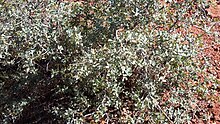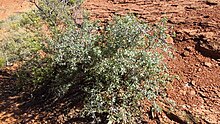|
Quercus turbinella
 Quercus turbinella is a North American species of oak known by the common names shrub oak, turbinella oak, shrub live oak, and gray oak.[4][5][6] It is native to Arizona, California, New Mexico, Utah, Colorado, and Nevada in the western United States.[4] It also occurs in northern Mexico.[7]  DescriptionQuercus turbinella is a shrub growing 2–5 metres (6+1⁄2–16+1⁄2 feet) in height but sometimes becoming treelike and exceeding 6 m (20 ft). The branches are gray or brown, the twigs often coated in short woolly fibers when young and becoming scaly with age. The thick, leathery evergreen leaves are up to 3 centimetres (1+1⁄4 inches) long by 2 cm (3⁄4 in) wide and are edged with large, spine-tipped teeth. They are gray-green to yellowish in color and waxy in texture on the upper surfaces, and yellowish and hairy or woolly and glandular on the lower surfaces. The males catkins are yellowish-green and the female flowers are in short spikes in the leaf axils, appearing at the same time as the new growth of leaves. The fruit is a yellowish brown acorn up to two centimeters long with a shallow warty cup about a centimeter wide.[7] This oak reproduces sexually via its acorns if there is enough moisture present, but more often it reproduces vegetatively by sprouting from its rhizome and root crown.[6][4] DistributionQuercus turbinella has been found in Arizona, New Mexico, Colorado, Utah, Nevada, southern California, and western Texas, as well as Baja California.[8][5] In California, it occurs in the New York mountains and a few eastern California desert ranges. The populations on the desert mountains in the western Mojave desert and the inner coastal ranges are now considered Quercus john-tuckeri.[9][10] It grows in woodland, chaparral, forest, and other habitat. It is most common in chaparral habitat in central Arizona,[6] through the transition zone of the Mogollon Rim–White Mountains, but also southeast Arizona in the Madrean Sky Island mountain ranges of sky islands.[11] EcologyQuercus turbinella easily hybridizes with other oak species, including Quercus gambelii, Q. havardii, Q. arizonica, and Q. grisea.[6] Many species of animals use it for food, with wild and domesticated ungulates browsing the foliage and many birds and mammals eating the acorns.[6] Animals also use the shrub as cover, and mountain lions hide their kills in the thickets.[6] See alsoReferencesWikimedia Commons has media related to Quercus turbinella.
External links |
||||||||||||||||||||||||||||||||||||||||||||||||
Portal di Ensiklopedia Dunia



